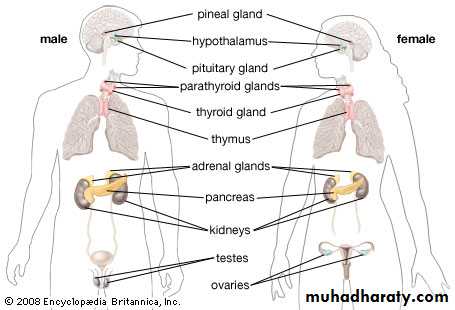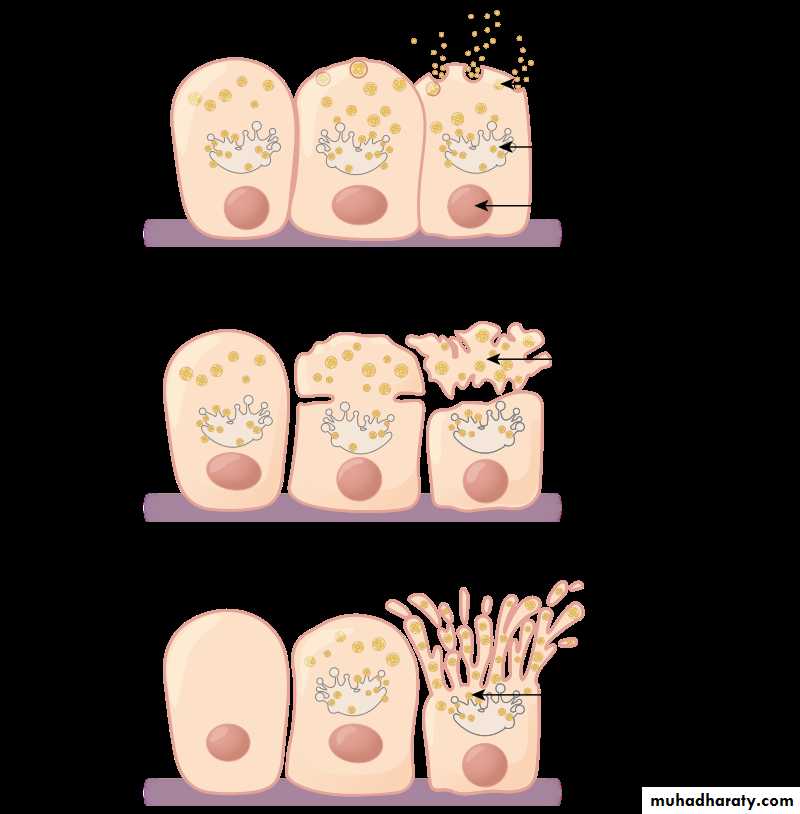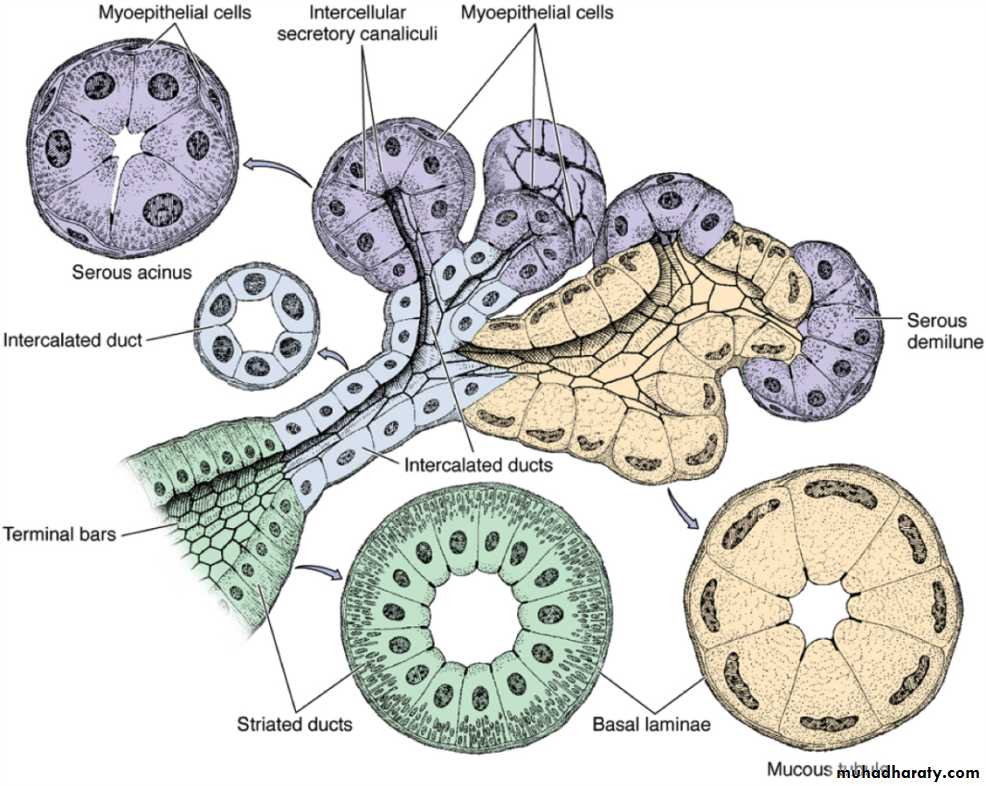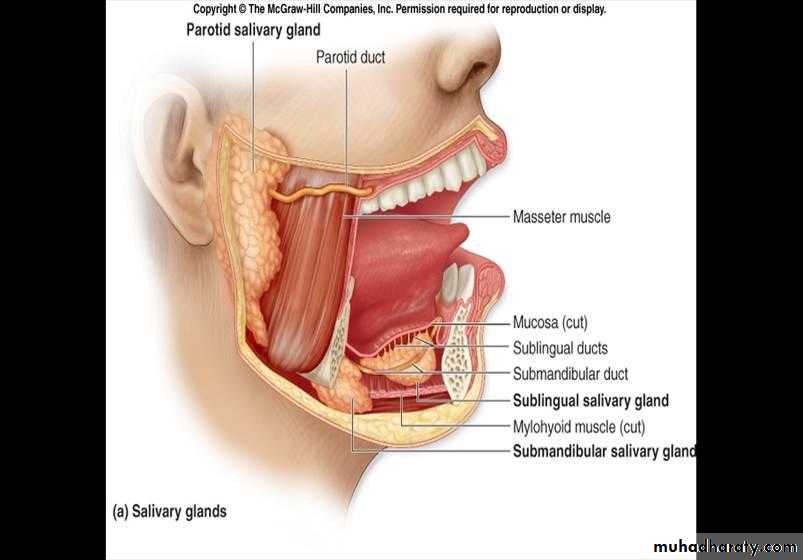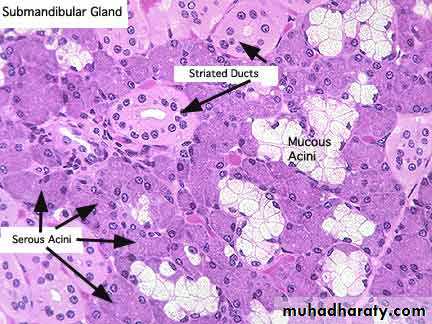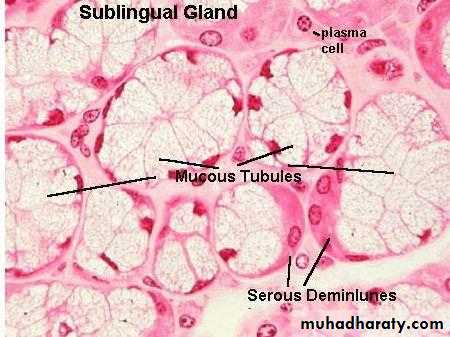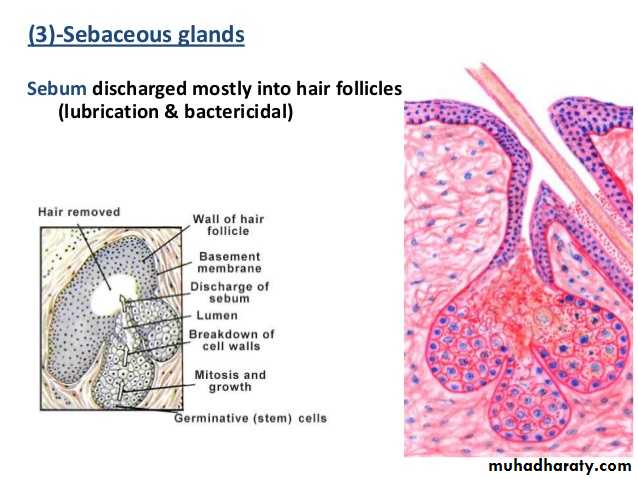2nd Lecture (15th – 21st Oct 2017)/3rd
Glands:Definitions of glands: (1). A single cell or a cluster of cells or an organ in the body that produces a substance (as saliva, sweat, or bile) to be used by the body or given off from it. According to number of cells they are made up of they could be classified to either single (unicellular or many cells, multicellular. (2). A specialized cell, group of cells, or organ of endothelial origin that selectively removes materials from the blood, concentrates or alters them, and secretes them for further use in the body or for elimination from the body. Glands synthesizes substances such as hormones to release into the bloodstream (endocrine gland) or into cavities inside the body or its outer surface (exocrine gland) or for discharge into the surroundings. Numerous glands exist throughout the human body including the head. They all are developed as either at the epithelial tissues i.e. goblet cells or as an in-growth from the epithelium down to the underneath Connective Tissue (Co.T.) where they reside for the rest of the life (Fig. 1, 2 and 3).
1 2 3 4 5
(Fig. 1): Various possible glandular arrangements. These are: (1): the simple tubular; (2): Simple branched tubular; (3): simple coiled tubular; (4): simple acinar, and (5): simple branched acinar glands, respectively.1 2 3
(Fig. 2): Various possible glandular arrangements. These are (1): Compound tubular; (2): Compound acinar and (3): Compound tubulo-acinar glands.Development:
Every gland is formed by an ingrowth from an epithelial surface which may at the beginning possess a tubular structure, but in other instances glands may start as a solid column of cells which subsequently becomes tubulated. As growth proceeds, the column of cells may divide or give off offshoots, in which case a compound gland is formed. In many glands the number of branches is limited, in others (salivary, pancreas) a very large structure is finally formed by repeated growth and sub-division. As a rule, the branches do not unite with one another, but in one instance, the liver, this does occur when a reticulated compound gland is produced. In compound glands the more typical or secretory epithelium is found forming the terminal portion of each branch, and the uniting portions form ducts and are lined with a less modified type of epithelial cell.
(Fig. 3): Shapes of glands, simple and compound.
Classification of Glands:
According to their shape.If the gland retains its shape as a tube throughout it is termed a tubular gland.
In the second main variety of gland the secretory portion is enlarged and the lumen variously increased in size, these are termed alveolar or saccular glands (Fig.4).
2). According to their Function
(Figure 4): The differences between Endocrine and Exocrine glands where the major difference is that Exocrine glands secrete substances out of the body and Endocrine glands secrete substances into capillaries and blood vessels.
The Endocrine System Essentials
The endocrine system is composed of a network of glands (Fig.5)..
These glands secrete hormones to regulate many bodily functions, including growth and metabolism.
Endocrine diseases are common and usually occur when glands produce an incorrect amount of hormones.
The endocrine system helps control the following processes and systems:
Growth and development
Homeostasis (the internal balance of body systems)
Metabolism (body energy levels)
Reproduction
Response to stimuli (stress and/or injury)
a). Endocrine glands:
The endocrine system is a complex collection of hormone-producing glands that control basic body functions such as metabolism, growth and sexual development. The endocrine glands consist of: pineal; thyroid and parathyroids; thymus; adrenals; pancreas; pituitary gland, ovaries (female); and testes (male). Endocrine glands secrete substances that circulate through the blood stream. These glands that secrete their products through the basal lamina into the blood stream and lack a duct system. These glands often secrete hormones, and play an important role in maintaining homeostasis.
"Hormones" are the chemical signaling molecules produced by the endocrine glands and secreted directly into the bloodstream. They travel through the blood to distant tissues and organs, where they can bind to specific cell sites called receptors. By binding to receptors, hormones trigger various responses in the tissues containing the receptors. In addition to the classical endocrine organs, many other cells in the body secrete hormones. Myocytes in the atria (single atrium) of the heart and scattered epithelial cells in the stomach and small intestine are examples of what is sometimes called the "diffuse" endocrine system. If the term hormone is defined broadly to include all secreted chemical messengers, then virtually all cells can be considered part of the endocrine system.
Tip: Advances in molecular genetics have led to a greatly strengthened understanding of the mechanisms of certain of the hereditary endocrine disorders. This section of genes and disease focuses on disorders for which the primary gene defect has been characterized or recently identified. This part will thoroughly be studied in another module.
The endocrine system includes all of the glands of the body and the hormones produced by those glands. The glands are controlled directly by stimulation from the nervous system (NS) as well as by chemical receptors in the blood and hormones produced by other glands. By regulating the functions of organs in the body, these glands help to maintain the body’s homeostasis. Cellular metabolism, reproduction, sexual development, sugar and mineral homeostasis, heart rate, and digestion are among the many processes regulated by the actions of hormones.
(Fig.5): Distribution of the glands of the human endocrine system.
b). Exocrine glands:Exocrine glands secrete their products through a duct onto an outer surface of the body i.e. the skin or the human gastrointestinal tract. Secretion is directly onto the apical surface. The glands in this group can be divided into three groups:
(a): Merocrine glands cells secrete their substances by exocytosis (e.g., mucous and serous glands). Also called "eccrine". e.g. max sweat gland of humans, goblet cells, salivary gland, tear gland, intestinal glands (Fig. 5a).
(2): Apocrine glands, a portion of the secreting cell's body is lost during secretion. Apocrine gland are those which use the apocrine method of secretion. e.g. mammery gland, sweat gland of arm pit, pubic region, skin around anus, lips, nipples (Fig 5b).
(3): Holocrine glands, the entire cell disintegrates to secrete its substances sebaceous gland (Fig. 5c).
(Fig. 6) Classification of glands upon their mode of secretion into (a): Merocrine;
(b): Apocrine and Holocrine glands.(Fig. 7): The development, production and secretion of a "holocrine" gland its contents of hormones.
(Fig. 8): Formation of hormones and mechanism of secretion.
(Fig 9): The mechanism of production, accumulation and secretion of the above three types of glands. Note the secreted hormones of each unicellular gland will be accumulated inside the lumen before they are secreted outside via a duct.
Classification according to The type of secretory product of exocrine glands may also be one of three categories:
(1): Serous glands secrete a watery fluid like, often protein-rich product e.g. sweat gland.
(2): Mucous glands secrete a viscous product, rich in carbohydrates (e.g., glycoproteins) goblet cell (Fig. 9).
(3): Sebaceous glands secrete a lipid product. These glands are also known as oil glands, e.g. skin, pancreas, gastric gland.
(Fig. 10): Anatomical differences between mucous and serous glands. Note that nuclei of Mucous glands are flattened and pushed towards the base due to the higher viscosity of the mucine. Both types of glands could make a mixed gland.
(Fig. 10A)
(Fig. 11A & B): Locations of the oral glands.
(Fig. 12): Mixed types of secretory produce glands are found within the glands located at the oral.
(Fig. 13): Shapes of mixed mucous and serous glands as found together making demilunes.
Skin: There are several specialized glands within the human integumentary system that are derived from apocrine or sebaceous gland precursors. There are no specialized variants of eccrine glands (Fig.14).(Fig. 14): Section in thin skin of human shows sebaceous gland.
Sebaceous Glands:Sebaceous glands are simple and branched tubular gland however, the secretory portion consists of alveoli. Basal cells in the outermost layer of the alveolus are flattened. Basal cells are mitotically active. Some of the new cells will replenish the pool of basal cells, while the remaining cells are displaced towards the centre of the alveolus as more cells are generated by the basal cells. The secretory cells will gradullay accumulate lipids and grow in size. Finally their nuclei disintegrate, and the cells rupture. The resulting secretory product of lipids and the constituents of the disintegrating cell is a holocrine secretion. They empty their secretory product into the upper parts of the hair follicles. They are therefore found in parts of the skin where hair is present. The hair follicle and its associated sebaceous gland form a pilosebaceous unit. Sebaceous glands are also found in some of the areas where no hair is present e.g. lips, oral surfaces of the cheeks and external genitalia.
The lipid secretion of the sebaceous glands has no softening effect on the skin, and it has only very limited antibacterial and antifungoid activity. Its importance in humans is unclear. Clinically the sebaceous glands are important in that they are liable to infections (e.g. with the development of acne).
Sweat Glands
Two types of sweat glands are present in humans. They are distinguished by their secretory mechanism into merocrine (~eccrine) sweat glands andapocrine sweat glands. In addition, they differ in their detailed histological appearance and in the composition of the sweat they secrete.
Merocrine sweat glands are the only glands of the skin with a clearly defined biological function. They are of critical importance for the regulation of body temperature. The skin contains ~3,000,000 sweat gland which are found all over the body - with the exception of, once again, parts of the external genitalia.Sweat glands are simple tubular glands. The secretory tubulus and the initial part of the excretory duct are coiled into a roughly spherical ball at the border between the dermis and hypodermis.
The secretory epithelium is cuboidal or low columnar. Two types of cells may be distinguished: a light type, which secretes the watery eccrine sweat, and a dark type, which may produce a mucin-like secretion. The cells have slightly different shapes and, as a result of the different shapes, the epithelium may appear pseudostratified.
A layer of myoepithelial cells is found between the secretory cells of the epithelium and the basement membrane.
The excretory duct has a stratified cuboidal epithelium (two layers of cells).
The excretory ducts of merocrine sweat glands empty directly onto the surface of the skin.
(Fig. 15): Section in skin shows a few sweat gland as simple tubular running down from epithelium down to the dermis to end up as simple tubular coiled gland.
Adenosis is any disease of a gland. The diseased gland has abnormal formation or development of glandular tissue which is sometimes tumorous.
Scientific tips:
Cavities (Tooth Decay): Cavities are areas of damaged tooth enamel that form when acid erodes away at a tooth.
What Causes Cavities? Bacteria are normally present on teeth as plaque. Bacteria produce acid as a byproduct from feeding on sugar in the diet. The acid produced then erodes the enamel and exposes dentin that, in turn, can become pitted and result in a cavity.





